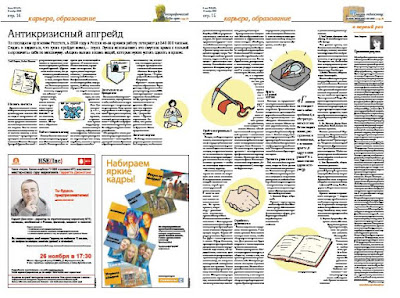Front pages of Welt am Sonntag


Top to bottom: April 26, 2009; April 19, 2009; March 1, 2009
Welt am Sonntag is a weekly published in Berlin, Germany with a circulation of 400,000. The design of this paper most closely resembles layouts of U.S. newspapers. The font and the lack of white space reminds me of the Wall St. Journal. Still, Welt am Sonntag uses many more graphic and colorful elements in its paper. The teasers at the top of the page also resemble teasers of our national papers, which have cutout images that may overlap the teaser headlines. Colored font like we've seen in the other European papers is not used in this paper.
After browsing back issues of Welt am Sonntag, I came across an unusual layout that I haven't seen in any of the other papers.
The April 5th, 2009 paper started out with this. Thinking it was some type of lead-in to a story, I flipped the page to find this:
An ad for a car. So, not that unusual seeing an ad as the first page of a paper because the real front page with the day's/week's headlines are typically found after the ad. Instead, Welt am Sonntag forfeited a front page for this week and went right to this spread after the ad:
Although there is still a contents section on the bottom left, I thought it was weird to not have a traditional front page. I'm sure the three-page ad was quite pricey, and it gave the paper some more revenue, but was it enough to forgo Welt am Sonntag's traditional front page? We talked in lecture about how advertising departments at papers usually have the upper-hand because without any revenue, there really is no way to publish what the reporters have written. I'm sure ad agencies understand the importance of news content to the paper because it affects who will actually read the paper, and therefore come across their ads. Hopefully these agencies will not
try to take too much control of the paper even if they are the main ones helping produce it...
Anyway, I've also noticed that this German paper frequently uses layouts that has a scrapbook-y feel. By that, I mean many of the pictures used in certain layouts are strewn across the page. Look at the layout above. The pictures on the right page are laid out in a liberal way. The white border of the photos also add to this scrapbook feel of the paper. Here is another example from the March 15, 2009 issue:

The right page uses an interesting use of open books to separate each little blurb, but I don't think tilting the text helps the reader. Also, because the books took up so much space, the photos on the pages of the book are quite small. I would have liked to see more of the pictures while also having more room so that the text could also be a bit larger.
Layouts should be appealing, but they should not sacrifice the ease of reading a story.
After browsing back issues of Welt am Sonntag, I came across an unusual layout that I haven't seen in any of the other papers.
The April 5th, 2009 paper started out with this. Thinking it was some type of lead-in to a story, I flipped the page to find this:
An ad for a car. So, not that unusual seeing an ad as the first page of a paper because the real front page with the day's/week's headlines are typically found after the ad. Instead, Welt am Sonntag forfeited a front page for this week and went right to this spread after the ad:
Although there is still a contents section on the bottom left, I thought it was weird to not have a traditional front page. I'm sure the three-page ad was quite pricey, and it gave the paper some more revenue, but was it enough to forgo Welt am Sonntag's traditional front page? We talked in lecture about how advertising departments at papers usually have the upper-hand because without any revenue, there really is no way to publish what the reporters have written. I'm sure ad agencies understand the importance of news content to the paper because it affects who will actually read the paper, and therefore come across their ads. Hopefully these agencies will not
try to take too much control of the paper even if they are the main ones helping produce it...
Anyway, I've also noticed that this German paper frequently uses layouts that has a scrapbook-y feel. By that, I mean many of the pictures used in certain layouts are strewn across the page. Look at the layout above. The pictures on the right page are laid out in a liberal way. The white border of the photos also add to this scrapbook feel of the paper. Here is another example from the March 15, 2009 issue:
I can't decide if using this type of layout for photos works with the paper. It contrasts with the very even columns of text, but I don't know if it adds any interesting element, or is just another obstacle for the reader to overcome when attempting to read the story. An even greater obstacle for the reader is if the text itself were tilted, as seen in this layout from the same issue:

The right page uses an interesting use of open books to separate each little blurb, but I don't think tilting the text helps the reader. Also, because the books took up so much space, the photos on the pages of the book are quite small. I would have liked to see more of the pictures while also having more room so that the text could also be a bit larger.
Layouts should be appealing, but they should not sacrifice the ease of reading a story.






































